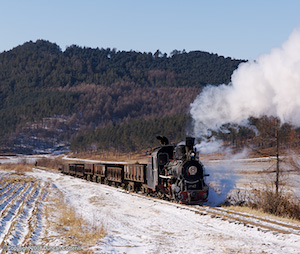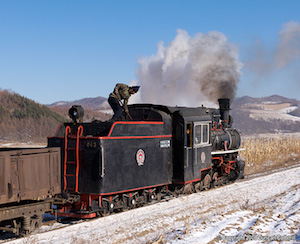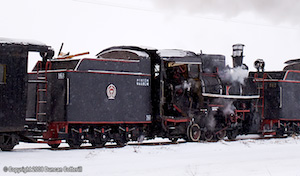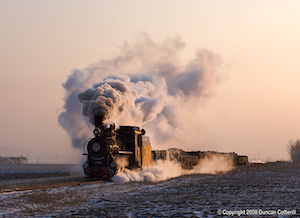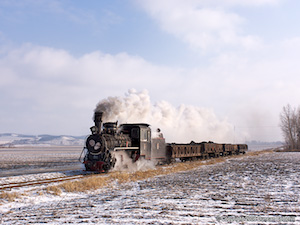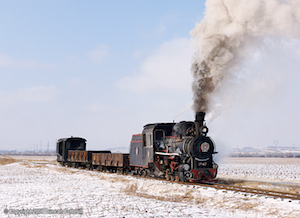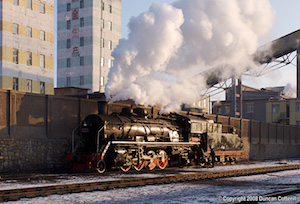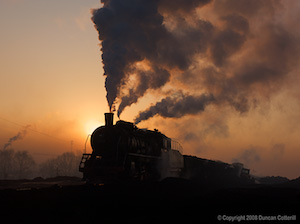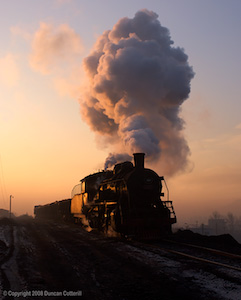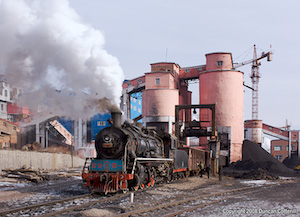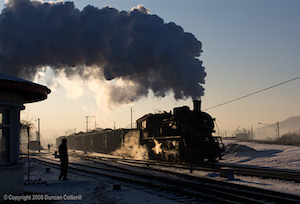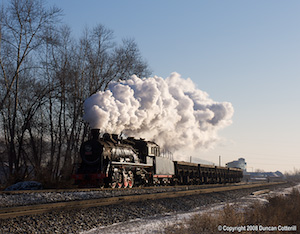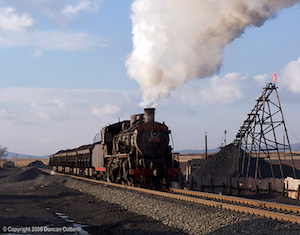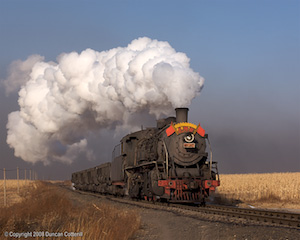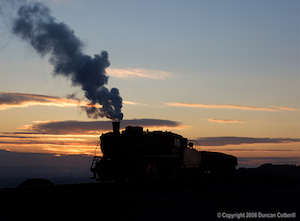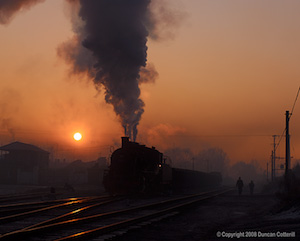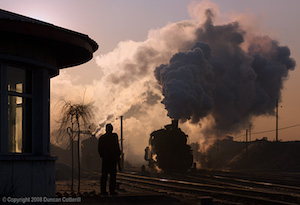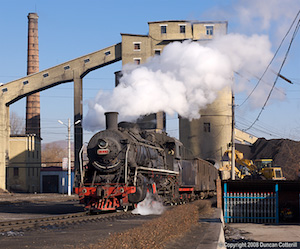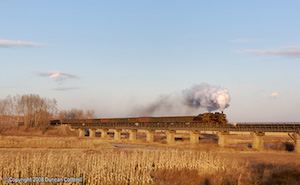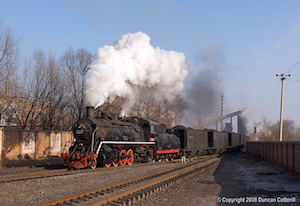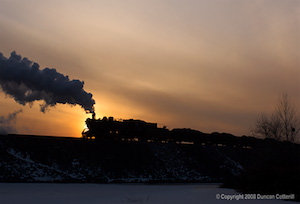North-East Steam
15 - 25 Nov 2008
Report by Duncan Cotterill
Introduction
After a diesel trip to China in October, it was soon time to go back for some winter steam. I travelled with Peter Breeze on a short trip to two of the best surviving operations. Mike Ma made all the arrangements within China and we had Tao from Mudanjiang as our guide.
We planned to start with a couple of days at Jixi, still a very steamy place despite the diesels at Hengshan and the recent arrival of second hand electrics at Chengzihe. The idea was then to move on to our prime objective, the narrow gauge operation at Huanan, potentially the best surviving narrow gauge line in China but notoriously unreliable these days.
This was to be my fifth visit to Huanan and my third winter trip there. Visits in November 2006 and November 2007 had produced few worthwhile pictures. The 2006 trip was dogged with very mixed weather and a much-reduced service due to multiple loco failures. 2007 was even worse as the line was closed for the duration because there was no fuel for the loading equipment. We were hoping it would be third time lucky but at the time we left home there were no reports that operations had restarted after the October Golden Week holiday.
Home to Huanan
I flew with Finnair from London Heathrow to Beijing via Helsinki and was surprised to find the flight from Heathrow to Helsinki was operated by British Airways under a codeshare arrangement and provided a rare opportunity to sample one of BA’s few remaining Boeing 757s. The Helsinki to Beijing leg was on a brand new Finnair A-340, so clean and shiny that it couldn’t have been in use for more than a few days.
We were met by Mike Ma after arrival in Beijing and told that Huanan had started working again a few days earlier but there was very little coal to shift and it was expected to stop again very soon. It didn’t take long to work out that we should change our plans and go to Huanan first. We flew up to Harbin on Air China flight CA1623 (B737) and met our guide for the trip, Tao, before catching train N75 overnight to Didao behind DF4D 3031. After half an hour’s photography at Didao at sunrise, we left for Huanan by road, arriving just after 09:00 on 16 November.
Huanan Forestry Railway
This 47km long 762mm gauge coal line is the remnant of an extensive forestry railway, most of which closed in the early 1990s. The line is described in detail elsewhere so I won’t elaborate here.
Operations have been particularly erratic this year and it was no great surprise when trains did not restart after the Golden Week holiday. There was no coal to haul due to safety problems at the mines. Trains finally started running around 10 November but there were only 2000 tons of coal to move and most of it had already been shifted by the time we arrived on 16 November.
The line was being operated with two locos instead of the usual three, which meant that loaded trains ran every eight hours or so instead of the usual four hourly intervals. This equates to only one train each way in daylight on most days. The railcar wasn’t running either, so there wasn't going to be much activity.
16/11 was bright and sunny but with a bitter northerly wind that blew the exhaust around unpredictably. We got a reasonable shot of No.043 with a train of empties on the climb from Tuoyaozi at 11:50 but were blown out by the wind when No.168, banked by No.043, approached the summit from the other direction with a train of loads at 13:30. Nothing else was expected to run before the next train of empties scheduled at around 19:00 from Huanan.
17/11 started dull with snow falling but the light improved after the day's action was over. We expected another train of loads to arrive from Hongguang during the morning but discovered that one of the locos had failed at Lixin and was being dragged back to Huanan by the other one. No.043 turned up at Tuoyaozi just after 09:00 with a damaged No.168 in tow and both were back in Huanan by 10:30. No.168 had obviously been involved in a collision of some sort and one side of the cab had been ripped away. One of the injectors had also been badly knocked but the loco was otherwise in working order. By this time No.11 was being steamed up to replace the damaged No.168, which retired to the shed. At 13:50, No.043 left light engine for Lixin but No.011 wasn’t expected to go until well after darkness. At this stage there were said to be two trainloads of coal waiting at Lixin or Hongguang and once they had been delivered to Huanan, operations would stop again until the mines received safety clearance.
18/11 was reasonably sunny west of Xiahua but very dull to the east. We didn't expect to see the first train of loads but hoped that we might catch the second train before it got to Huanan. A pre-dawn visit to the station elicited the information that a train was expected to arrive in a few minutes. We set off in search of a location, half expecting the train to reach Huanan before there was any light.
It didn't take long to find No.043, failed a few km west of Huanan. After we gave one of the crew a lift to the depot to get the regulator valve repaired, the train got underway again in good light and produced the best shot of the day. It soon became clear that this was the first train and the second train was also on its way.
No.11 followed with four loaded wagons, arriving at Huanan at 10:00. We had expected that to be it but No.043 left for Hongguang again at 11:30 with two empty wagons and a brake van. It was due to return after dark with just the brake van, bringing operations to a close for the foreseeable future. Nobody was sure when the line would reopen but there was no suggestion that it was expected to close permanently. We left Huanan for Jixi in the early afternoon.
Locos : 011, 043, 168 in use.
Jixi Mining Railways
This was our sixth visit to Jixi in under four years and, like the previous trip in November 2007, turned out to be much longer than planned due to the lack of trains at Huanan. We spent 6 days from 19 to 24 November there. Fortunately, Jixi is still a superb steam centre with a wide variety of good locations and enough action to satisfy the most demanding photographer. We tried to concentrate on shots we hadn’t done before and were helped to some extent by changes in the operation at Chengzihe. In general the weather was good apart from one cloudy morning and one cloudy afternoon. Otherwise, there was little cloud to interrupt the sunshine. The weather was very cold with a strong west-north-westerly wind blowing every day from mid morning onwards.
Chengzihe
This remains an excellent system with plenty of steam action. The most important observation was the complete lack of electrification work. The eight electric locos were safely locked away in a fenced and roofed compound at Nanchang. No masts were seen and there were no obvious preparations for electrification either. Work is expected to start after the Spring thaw but for the moment, it’s still well worth a visit.
The track layout at Dongchang has been modified with a long loop replacing the short siding that ended in front of the coal loader. In order to accommodate the new loop, the main line has been moved a couple of metres to the south and is now close to the boundary wall. This makes conventional photography more difficult and has also discouraged most of the pedestrian traffic through the yard. During our visit, the new loop was always full of empty wagons, restricting the possibility of against-the-light shots at dawn. Hard though it is to believe, there actually seems to be a glut of empty wagons at the moment, contrasting with the severe shortages of previous years.
Another development that reduced the scope for photography at Dongchang was the diversion of the spoil trains from Beichang washery. Instead of heading east to the traditional spoil tip beyond Dongchang, these workings went west, over the river bridge to Qiaonan where they reversed up the branch to the new mines south of the river and dumped their spoil near the first mine. Trains were still chimney first out of Beichang with SY 1544 being the regular engine.
We spent some time west of Xinghua Mine on the line to Zhengyang and found it to be quite busy with spoil trains running between Xinghua and the tip a couple of km to the west. At times there was a loaded train every 45 minutes or so. The loaded workings were propelled tender-first uphill with the returns chimney-first downhill but there were still some worthwhile photographic possibilities. One working worthy of note was a regular loaded spoil train from Zhengyang Mine to the tip west of Xinghua. This ran around 09:00 every morning, giving the chance to get a chimney first loaded train working uphill. SY 1437 was the regular engine for all these spoil workings.
Coal trains were infrequent on the Xinghua line but there was usually a train of empties to the mine at some point during the morning. These trains sometimes ran tender first from Zhengyang.
The previous situation where locos were permanently allocated to one system appears to have changed with SY 0341 arriving from Hengshan while SY 0590 has gone to Donghai and SY 1344 to Hengshan. SY 1340 had been overhauled recently and was still rather shiny but it was the only clean engine. Even SY 1544 was looking a bit scruffy and SY 0341 and SY 0863 were absolutely filthy.
Locos : SY 0341, 0863, 1058, 1340, 1351, 1369, 1437, 1544 in use.
Didao
With the changes at Chengzihe-Dongchang making dawn photo sessions there far less rewarding than on previous visits, we spent most early mornings at Didao-Hebei Washery. Overall, Didao was fairly busy with four locos in use on most days. What was striking was the variation in activity from one day to the next, both in volume terms and the type of workings that ran. No two days were remotely similar and there was no telling whether it would be busy or quiet on any particular day or which trains would run.
Didao doesn't seem to have participated in the great locomotive exchange. We saw all five of the locomotives usually based there although there was only one occasion when all five were present at the same time. SY 0950 appeared to have been overhauled very recently and was still extremely clean.
Locos : SY 0407, 0950, 1205, 1213, 1446 in use.
Donghai
Donghai is probably the least visited of all the Jixi systems and it takes a lot of patience to get anything worthwhile photographically. We spent two full afternoons on the line waiting for trains of empties from Jidong that failed to show up before sunset. Another visit occupied most of a third day but did yield some shots of shunting at the mine. After an extremely long wait, SY 0746 was photographed storming across the river bridge on the CR main line at full tilt with a train of loads . In total, we devoted more than a quarter of our time at Jixi to the Donghai system and got one good picture.
There are still two engines based at Donghai. On our first two visits, SY 0590 was stabled at the mine, in steam but with nothing to do until the other engine (which we never saw) returned from Jidong with empties. Our final visit found SY 0639 shunting the mine and SY 0746 working over the line to Jidong.
Locos : SY 0590, 0639, 0746 in use.
Hengshan
We had been told that the diesels weren’t being used to their full potential and there was still plenty of work for the remaining SYs here but a short visit found the diesels busy and the SYs with little work to keep them occupied.
The line to Erkuang mine looked to be out of use with rusty rails at the Hengshan end where it crosses the road. It therefore came as a great surprise to see a diesel parked at the mine in the position where SY 0898 was usually parked. The diesel was green with yellow lining and from a distance appeared to be similar size and shape to a DFH5. There was no sign of the SY.
Locos : SY 0804, 1344, GKD1A 0106, 0107 in use.
Lishu
With the closure of the line to Qikeng, most activity now centres on Pinggang mine. We found SY 0951 working the spoil tip there and SY 1118 shunting the loader. This was a painfully slow process involving numerous passes under the silos while a small amount of coal was added to each wagon in turn. The process of loading took many hours and we didn’t wait for it to finish. There was no sign of the third engine, SY 0477, either at Pinggang or Lishu.
Locos : SY 0951, 1118 in use.
Other Jixi Mining Lines
A large orange industrial diesel was seen at the mine south of the main line west of Jixi Xi, near to the the junction of the Xiachengzi and Linkou lines on 18 November.
CR in the Jixi Area
Relatively little time was spent in the vicinity of the the main line but a few CR trains were seen. On 21 November, DF4 3805 (MDJ) was seen heading west past Didao at 08:00. A number of DF8s were also seen on freights in the Didao area but none were identified. DF4D 3033 was seen passing Didao on train N75 on 22 November.
East of Jixi, a number of trains were seen on 23 November. Most passengers were hauled by orange DF4Bs but N78 was hauled by DF4D 3296 and 6224 by DF4D 3317. A green DF4B was seen on an eastbound freight.
Jixi to Home
Our original plan had been to finish the trip at Huanan and then catch the overnight train from Qitaihe to Harbin but being in Jixi meant we should have been able to catch train N76 from there instead. Unfortunately there were no soft sleepers available so we went back to plan A and travelled to Qitaihe by road to catch train N26 instead. DF4D 3019 hauled the train from Qitaihe and was still on the front when we arrived at Harbin the following morning.
Three hours after arriving in Harbin we were on our way again on train D28, a high-speed service to Beijing covering the 1249 km in just over 8 hours at an average speed of 150 km/h. The train was formed of two seven-car CRH5 units.
When I started visiting China, Harbin to Beijing involved spending a night and most of the next day on the train, so doing the whole journey in daylight was something that had to be tried. Despite precise timekeeping and travelling in first class where the seating was 2+2 with generous legroom, it was a very disappointing journey. Approximately 50% of seats lined up with the windows but the rest had virtually no view at all. All you had to look at was a blank wall to the side and the high back of the seat in front. Even peering over the seat back in front didn't help. The small windows meant that you couldn’t really see a lot. By now you’ll have guessed which seats we had!
There was an SY in steam at the power station south of the line west of Huanggutun (Shenyang) and there were a lot of SS1s on freight around Shanhaiguan / Qinhuangdao but no other meaningful observations were made. We’d have probably seen more of the railway by flying.
After a night at the Sino-Swiss hotel at Beijing Airport, we returned to the UK via Helsinki on Finnair. Motive power was an A340 from Beijing to Helsinki and an A321 on to Heathrow.
Comments
Oh dear, another fine mess at Huanan, now officially the world’s least reliable steam operation. Our visit there was hardly a great success but in the circumstances, we were extremely fortunate to get anything at all.
Who knows what the future holds for Huanan? The decision seems to be down to the government’s mine safety inspectors. With safety standards being raised all the time and the economic downturn leading to overcapacity in the Chinese coal industry, it wouldn’t be surprising if the mines at Hongguang were forced to close permanently. If the mines don’t reopen then the railway is finished. Since the closure of the last steam worked forestry lines over five years ago, Huanan has been in a class of its own and it would be a very sad loss if those little 0-8-0s don’t take to the mountains again.
Once again, when things went horribly wrong at Huanan, Jixi saved the day. It's still a fantastic place to photograph steam and even after spending around 30 days there, I’m still finding new shots. There can’t be anywhere else left that has the quality or variety of locations or the volume of workings that can be seen at Jixi. Whether you want conventionally lit shots, glints, silhouettes, misty atmospherics, multiple locos, decorated locos, rural landscapes, local colour, industrial backgrounds, hard working engines or fast moving trains, Jixi has them all. If you haven't been, drop everything and go now before the poles go up at Chengzihe.
Fortunately, the hostility and suspicion I encountered while photographing diesels in October weren’t repeated. Everyone at Huanan and Jixi was as friendly as in previous years. The only suspicion we encountered was at the bridge east of Jidong where the bridge tender was a little worried about what we were up to. However, a talk with our guide and a couple of pictures of steam locos reassured him that we were harmless railfans. He had been based there for several years but claimed he had never seen any westerners taking photos there before.
Chinese steam isn’t finished yet, so where was everybody? With the demise of most of the other top class steam locations over recent years, we half expected Jixi to be mobbed with gricers, but it wasn't. In fact, we only saw one group of three gricers the whole time we were there and then our paths only crossed briefly.
There may not be the same volume or variety of steam operations as there was a few years ago but there are still several superb lines left, for the time being at least. Long may they continue.
